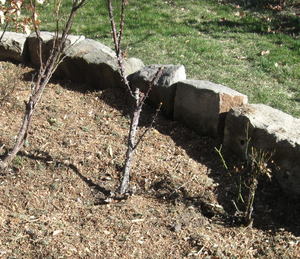Back in the days before concrete, sandstone was widely used in the West to build commercial buildings or foundations for residential homes. Sandstone had the advantage of being strong enough for commercial construction projects though was quite easy to chisel into uniformly sized pavers and construction stone.
Sandstone often turns up in salvage yards as old buildings are torn down, or foundations are replaced. Because salvaged sandstone is cheap and easy to work with, this product often turns up in landscaping designs. Where I live, many gardeners use sandstone to create a raised flower bed, to edge a walk way, or add architectural interest to a corner of the yard.
If you are interested in incorporating some sandstone in your garden, these tips will help:
Where to find old sandstone. While it’s still possible to purchase new sandstone, it’s the salvaged sandstone that has the most character. Salvaged sandstone is quite a bit cheaper in cost than brand new and is generally available at landscape nurseries, salvage yards, or construction salvage sites. Prices vary, though in today’s economy you probably won’t pay more than $100 for a ton.
Sandstone is quite heavy however and will require a couple of people to lift the individual stones into the bed of a truck, and eventually onto the yard. Salvaged sandstone blocks can weigh between 75 to 150 pounds each and are best hauled around the yard in a low yard cart or wagon.
Resizing the sandstone. Recycled sandstone is not always uniformly sized and won’t fit tightly together if you’re planning on building a raised bed or a retaining wall. To reshape the sandstone, it’ll be necessary to use a stone chisel and a wooden or rubber mallet to trim the sandstone so it can fit snugly against the next block. Most stone chisels cost around $20-50 dollars depending on the size and quality, and are available at hardware stores.
While these stone chisels aren’t designed for breaking sandstone in half or carving a statue, a steel chisel will allow you to slice off small end sections at a time so that adjacent stones will fit more tightly against each other.
Wear gloves and get some help. Because sandstone is so heavy, it’s best to sketch out an idea for your garden first before actually moving the stones into position. We wear gloves when working with sandstone in our yard, and work in teams of two to set the stones in place.
Set the stones in the ground for stability. While square sandstone blocks don’t tip over, some of the more irregularly shaped blocks have a tendency to topple when brushed against. To stabilize these blocks, it’s best to set them in a trench that is at least 4 inches in depth and then back filling the gaps with gravel and dirt.
Aside from the weight, sandstone blocks really are quite easy to work with and can add lots of eye appeal to most gardens. Best off all, they are impervious to all types of weather conditions and can be reused and recycled throughout the yard as gardening trends change.


